CM609: Understanding why Betelgeuse has great but variable brightness --
The structures of Transition Stars
David Noel
<davidn@aoi.com.au>
Ben Franklin Centre for Theoretical Research
PO Box 27, Subiaco, WA 6008, Australia.
About Betelgeuse
Betelgeuse is usually the tenth brightest star in the sky, an easily visible red star in the constellation of Orion. It is a huge object, classified as a Red Supergiant.
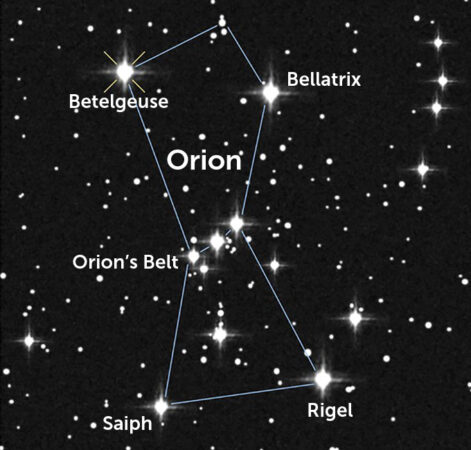
Figure CM609-F1. Stars in the constellation Orion. From [3].
Over the years, Betelgeuse has presented some interesting puzzles for astronomers. Most of the stars visible with the naked eye from Earth are standard "Fusion" stars -- these stars fall on the "Main Sequence" of the Hertzsprung-Russell diagram, the diagonal band running from top left to bottom right in Figure F2.
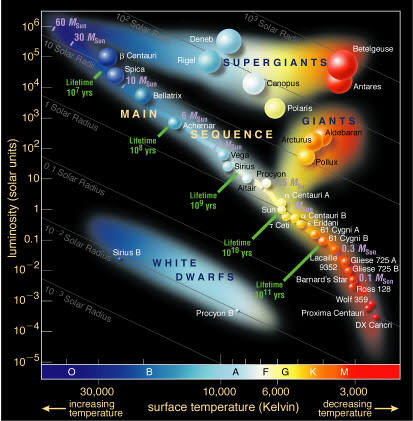
Figure CM609-F2. The Hertzsprung-Russell diagram. From [2].
These Main Sequence stars, which are almost all within the confines of our own Milky Way galaxy, follow surprisingly strict rules in their nature and longevity. Those of lower mass are smaller, redder (and so have lower-temperature radiating surfaces), and more long-lived, than stars with the opposite characteristics. The rules are such that if you know the mass of a Fusion star, you can calculate its surface temperature and lifetime with fair accuracy.
Above and below the Main Sequence lie stars which do not conform to these rules, including various "Giant" and "Dwarf" types. One of these is Betelgeuse, which is classed as a Red Supergiant.
The Giant stars on the Hertzsprung-Russell diagram do not follow the same rules as the Main Sequence stars, because they are not Fusion stars. But they do follow the Laws of Physics, and these Laws allow us to see why Betelgeuse is such a bright star in our sky.
Why is Betelgeuse very bright?
Why is Betelgeuse so bright? Googling this question, surprisingly, doesn't give you a direct answer. But a simple explanation is available, it's to do with what's called the Planck Radiation Law.
Max Planck was a brilliant German physicist. In 1900 he developed a law which shows how the amount of radiation from any surface depends directly on that surface's temperature. This is called Black-Body Radiation.
Around the same time, Wilhelm Wien discovered that the peak of the radiation curve varied with the temperature of the emitting body -- hotter bodies radiated with shorter wavelengths (higher energies). The peak wavelength was inversely proportional to the temperature.
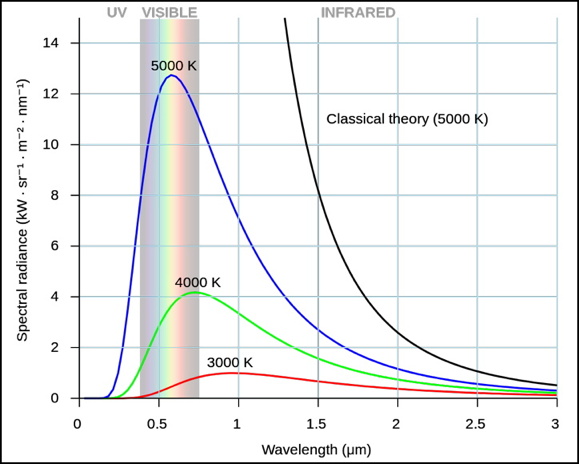
Figure CM609-F3. Black-body radiation curves. From [6].
Figure F3 shows examples of the black-body radiation from bodies at various temperatures. On the blue curve marked 5000 K (which is close to the temperature of our Sun's radiating outer surface), the peak radiation has a wavelength of about 0.6 microns, which corresponds to yellow light. Its intensity is just under 13 in the vertical scale units.
The intensity is also proportional to the area of the radiating surface, so a large star, with a large surface area, puts out a lot more radiation than another smaller star with the same temperature. The surface area of a sphere increases as the square of its radius, so that if one star had a given radius, and another similar star had twice the radius, the latter would put out 4 times the radiation.
The radiation intensity also falls off with increasing peak wavelength. The green line in Figure F3 represents a cooler star with a temperature of about 4000 K -- this star has its peak in the red wavelengths. For the same surface area (same size), the red star would put out 4/13, less than one-third as much radiation, as a yellow star.
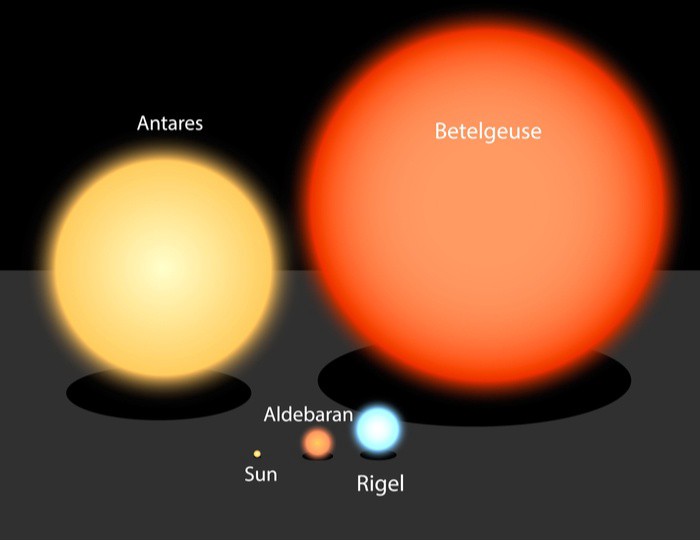
Figure CM609-F4. Comparative sizes of various stars. From [5].
Figure F4 shows the relative sizes of some stars. It can be seen how enormous Betelgeuse is compared to our Sun -- if a sphere the size of Betelgeuse was imposed on our solar system, it would reach out close to the orbit of Jupiter, enclosing all four inner planets and the Asteroid Belt.
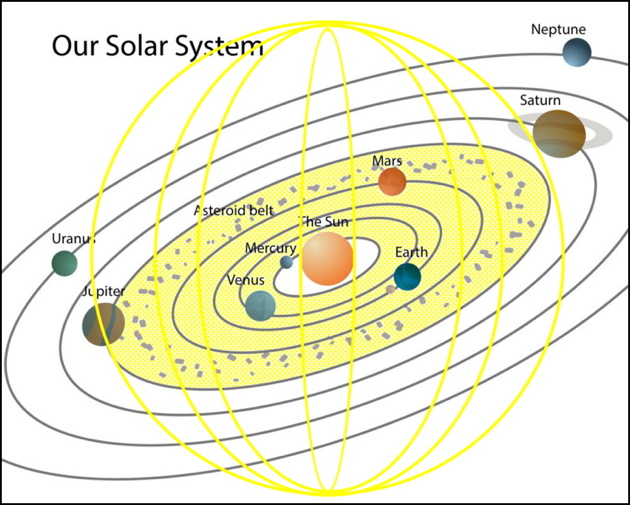
Figure CM609-F5. The Solar System with Betelgeuse superimposed (yellow -- not to scale).
Betelgeuse is so enormous, with such an immense area of radiating surface, that it is clear why its intrinsic intensity is so high. If this surface was somewhat hotter, so it radiated with a peak in the yellow wavelengths, it would be perhaps 3 times as bright!
There is more detail on the work of Planck and Wien with black-body radiation in P3: Living In The Universe [6].
Why does Betelgeuse vary so much in brightness?
Betelgeuse is notable for changes in its brightness, and is formally classed as a "pulsating semiregular variable star" [1]. Some of the changes are regular, some sporadic. A notable change occurred in the years 2019-2020.
According to [1], "Starting in October 2019, Betelgeuse began to dim noticeably, and by mid-February 2020 its brightness had dropped by a factor of approximately 3, from magnitude 0.5 to 1.7. By 22 February 2020, Betelgeuse stopped dimming and started to brighten again. Infrared observations found no significant change in brightness over the last 50 years, suggesting that the dimming is due to a change in extinction [screening], rather than an underlying change in the luminosity of the star.
Further studies suggested that occluding "large-grain circumstellar dust" may be the most likely explanation for the dimming of the star".
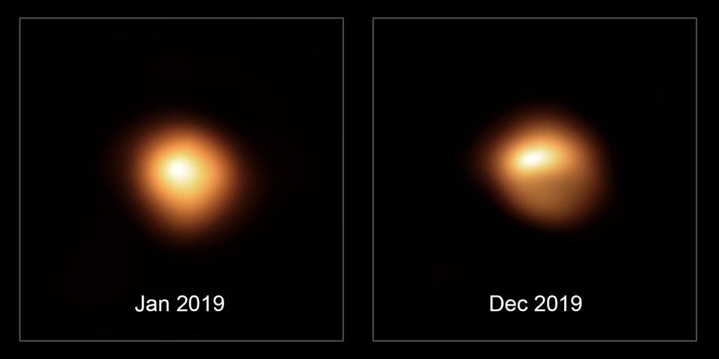
Figure CM609-F6. Images of Betelgeuse taken in January 2019 and December 2019, showing the changes in brightness and shape. From [4].
Notice also, in Figure F6, that the brighter parts of the image are not symmetrical. The comment above on infrared observations suggests that some of the brightness variations are due to changes in physical components which are emitting in visible light, while other parts emitting in infrared (and so of cooler temperatures) are not changing.
A Hubble image taken in 1995 [1] showed this image contained a bright patch indicating a region in the southwestern quadrant 2,000 K hotter than the general stellar surface. This is a very significant difference, one which has never been explained until now.
Some of the changes shown by Betelgeuse have regular cycles. Astronomers theorize that a coincidence of a normal 5.9 year light-cycle minimum and a deeper-than-normal 425 day period are the driving factors [1]. Other possible causes were an eruption of gas or dust, or fluctuations in the star's surface brightness.
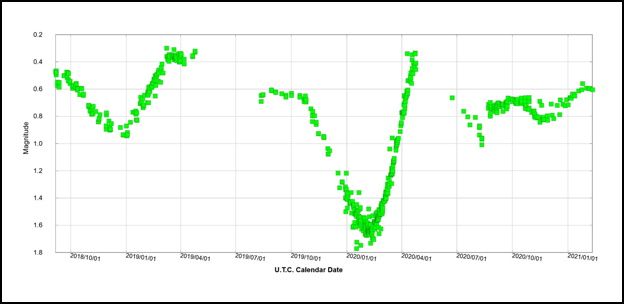
Figure CM609-F7. AAVSO V-band magnitude of Betelgeuse, between September 2018 and February 2021. From [1].
The diameter of Betelgeuse appears not only varying with time, measured values depend on the wavelength of radiation involved. At various wavelengths within the electromagnetic spectrum, the difference in reported diameters can be as much as 30-35% [1]. The measured angular diameter is considerably larger at ultraviolet wavelengths, decreases through the visible, to a minimum in the near-infrared, and increase again in the mid-infrared spectrum.
What's really happening with Betelgeuse?
To understand the reason for these somewhat confusing measurements of Betelgeuse, we need first to look at the general case, that of how stars go through particular life cycles.
It was mentioned above that the life cycles of normal (Fusion) stars, those on the Main Sequence of the Hertzsprung-Russell diagram shown in Figure F2, depend on their masses. Massive stars go through their life cycles very quickly, low-mass stars very slowly.
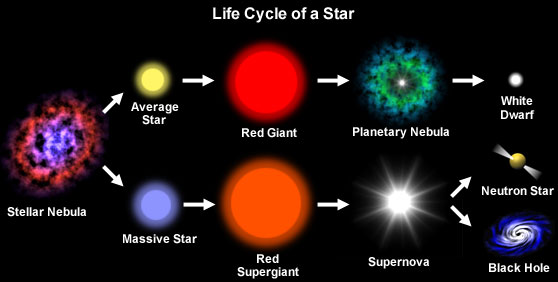
Figure CM609-F8. The Life Cycle of stars. From [2].
Figure F8 shows life cycles for stars of various masses. It is accepted that all Fusion stars form by the gravitational aggregation of interstellar matter, though details may be disputed. It's also accepted that all such stars produce their energy through the fusion of lower-mass elements within them, first the fusion of hydrogen into helium, and then progressively into heavier and heavier elements.
Eventually the fuel used in fusion comes to an end, and the star comes to the end of its life as a Fusion star, and begins a major transformation. The transformation can be very rapid, when it has been described as an explosion, or relatively slow, and described as expansion or swelling. Here we call this stage the Blowup.
When the transformation stage is completed, it leaves behind a massive object variously called a White Dwarf, a Neutron Star, or a Black Hole. Everything so far is generally accepted. We go on now to explanations which are fairly obvious from the evidence available, but which have not been generally expressed.

Quotation CM609-Q1.
In this newer explanation, the Blowup stage of a fusion star is called a Transition Star, and involves the original star splitting into two parts, the Shell and the Core. The original mass is also divided between the two parts -- these may be roughly equal, or more may go to the Shell, or more to the Core.
In any event, it is the Core portion left behind after the Blowup which we recognize as a White Dwarf, a Neutron Star, or a Black Hole. All these objects are very massive, very rapidly-rotating objects, here classed as Vortex Stars.
Vortex Stars are not more or less spherical objects like Fusion Stars, and do not emit light in all directions from their surfaces. Vortex Stars do emit radiation, but as very narrow beams along their axes of rotation.
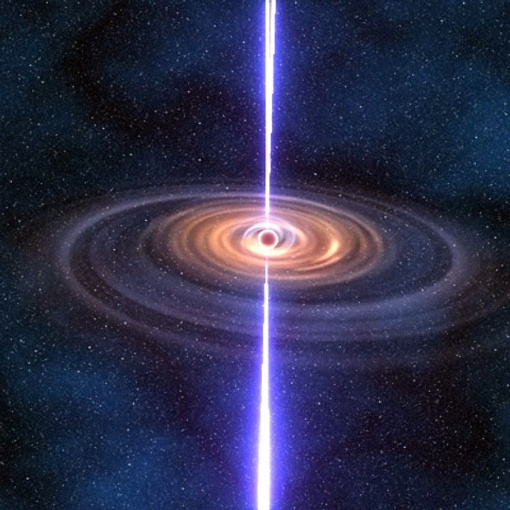
Figure CM609-F9. Artist's conception of a vortex star. From [2].
There is more detail on this in UG102: Understanding Vortex Stars -- White Dwarfs, Neutron Stars, Black Holes, and AGNs [2].
Because Vortex Stars emit radiation (and in some cases, particles) along these narrow beams, their appearance depends strongly on the angle of view. Only when viewed head-on, directly on an axis, will they appear extremely bright. At any other angle, what is viewed are normally secondary effects from the passage of the beams through their nearer spaces.
The Shell portion resulting from the Blowout is entirely different to the Core. It is an expanding shell of material, without any energy-producing mechanism of its own. Its fate is to expand and dissipate into surrounding space, until no parts are left with a regular enough surface at a high enough temperature to produce light.
Transition Stars are Composites of outer Shell and inner Core
If the Shell contains no energy-producing mechanism, how can a Transition Star continue to shine for astronomically long periods?
The answer is, that the outer surface of a Transition Star is continually supplied with energy produced by the Vortex Star contained within it. Because the Vortex Star emits energy in beams, rather than in all directions like a Fusion Star, the transition star surface may show irregularities in brightness, depending on the paths that energy takes to get from Core to Shell.

Proposition CM609-P1.
Although this is probably a new suggestion, the picture is not very different to the conventional idea of how our Sun produces its radiation. The light we see from the Sun is all from its outermost layer, the Photosphere, which is at a temperature of about 5000 K (Figure F3). This is powered by energy from processes deep within the Sun.
When the Blowup of a star occurs, it is noteworthy that the Shell may contain half, or more, of the original mass of the Fusion Star from which it came. This mass is spread out in interstellar space, ready for gravitational aggregation into a new Fusion Star.
This fits in neatly with the idea that the Universe itself is not bounded in time or space, but contains structures which recycle mass and radiation in a continuous renewal process.
There is more detail on this in UG101: Recycling the Universe -- Neutron Stars, Black Holes, and the Science of Stuff [8].
Betelgeuse is a Transition Star
It should be evident from the foregoing that Betelgeuse is a Transition Star. It has resulted from the Blowup of a Fusion Star. What we see of it at the present time is the Shell portion of the event, a rapidly-expanding structure without any energy-generating mechanism.
But contained within it, is its Core, an incipient Vortex Star. This is supplying the energy to keep the Shell materials at a high enough temperature to radiate in the visible spectrum. Because the output from the Vortex Star is not symmetrical, the appearance of the Shell shows considerable variation, and this explains a part of the Shell being 2000 K hotter than the rest.
So Transition Stars, by their nature, consist of two parts. We only see the outer part, the Shell, until it has expanded and dissipated enough to reveal the inner Vortex Star.
When the Shell has broken up into disconnected parts, it may remain visible as a Nebula -- in Figure F8, a Red Giant is shown evolving into a "planetary nebula" -- a bit of a misnomer, as planets are not involved.
A striking Hubble Telescope image, released in 2021 [7], shows the late transition stage of a blue giant star called AG Carinae. This giant, ultra-bright star, 20,000 light-years away from Earth, is classed as a Luminous Blue Variable.
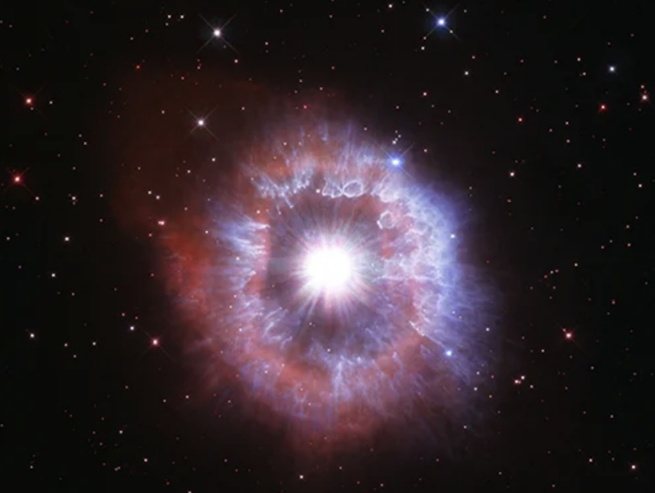
Figure CM609-F10. The Blowup of AG Carinae. From [7].
Some 70 times bigger and around 1 million times brighter than our own Sun, what you can see around AG Carinae is a gigantic nebula, an expanding shell of gas and dust, around five light-years wide [7]. Stellar winds are traveling away from the star at around 1 million kilometers per hour, eventually catching up to the circling material and pushing it out into space [7].
Is Betelgeuse going Supernova?
When a Blowup is quite rapid, it is often called called a Supernova. Supernovas can burst into view as very high sources of light radiation, often only lasting a few days or weeks, then fading fairly rapidly.
Speculation that Betelgeuse might be about to explode as a supernova is common [1]. In [3] it says "What they do know is that Betelgeuse is running out of time. It's less than 10 million years old, a youngster compared with the roughly 4.6-billion-year-old sun. But because Betelgeuse is so massive and burns through its fuel so quickly, it's already in the final life stage of a red supergiant. Someday in the not too distant future, the star won't be able to support its own weight -- it will collapse in on itself and rebound in a supernova".
You can see now how such speculation is far too late. Betelgeuse entered its Blowup, as a Transition Star, long ago -- the quote above suggests it was 10 million years ago (not long compared with typical star lifetimes, our Sun's lifetime is estimated at 10 billion years).
At present, we are just waiting for the Shell clouds to blow away, eventually to expose its Core Vortex Star, as has AG Carinae. In [1] it sums up the situation by saying Betelgeuse "is also surrounded by a complex, asymmetric envelope, roughly 250 times the size of the star, caused by mass loss from the star itself".
* * * * * * * * * * * * * * * * * * * * * * * *

References and Links
[1]. Betelgeuse. https://en.wikipedia.org/wiki/Betelgeuse.
[2]. David Noel. UG102: Understanding Vortex Stars -- White Dwarfs, Neutron Stars, Black Holes, and AGNs . http://aoi.com.au/UG/UG102/index.htm .
[3]. Lisa Grossman. Betelgeuse went dark, but didn't go supernova. What happened?. https://www.sciencenews.org/article/betelgeuse-star-dim-supernova-death-what-happened .
[4]. Jamie Carter. Now What's Going On With Betelgeuse? The "Future Supernova" Just Isn't That Cool, Say Astronomers. https://www.forbes.com/sites/jamiecartereurope/2020/03/06/now-whats-going-on-with-betelgeuse-the-future-supernova-just-isnt-that-cool-say-astronomers/ .
[5]. Ruth Ng. What Will Happen When Betelgeuse Goes Supernova?. https://medium.com/@ruth.ym.ng/what-will-happen-when-betelgeuse-goes-supernova-e4d25cac9f0c .
[6]. David Noel. P3: Living In The Universe. http://aoi.com.au/Living/ .
[7]. Breathtaking New Hubble Image Shows a Giant Star on The Brink of Annihilation. https://www.sciencealert.com/breathtaking-new-hubble-image-shows-a-giant-star-on-the-edge-of-annihilation.
[8]. David Noel. UG101: Recycling the Universe -- Neutron Stars, Black Holes, and the Science of Stuff. http://www.aoi.com.au/Recycling/ .
Go to the Cameos Home Page
Go to the AOI Master Page
Assembly started 2021 Apr 12. Version 1.0 up on web 2021 May 5.














